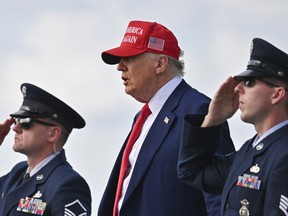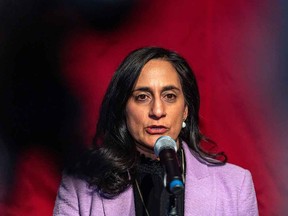Expert suggests the United States has long held issue with Canada’s GST
Article content
After United States President Donald Trump announced on Thursday that he would be imposing reciprocal tariffs in response to “unfair” trade practices from other countries, sources revealed that Canada’s goods and services tax could be a potential target.
Article content
Article content
Two senior Canadian government sources told Radio-Canada on Thursday that Trump views Canada’s GST as a tariff, raising the issue during his call with Prime Minister Justin Trudeau on Feb. 3.
Advertisement 2
Article content
While Trudeau reportedly pointed to several American states, such as Florida, with sales taxes of their own, Trump’s issue is with the fact that Canada has a federal sales tax and the U.S. does not.
Here’s what you need to know about the latest target in Trump’s growing list of tariff threats.
Why would Trump take issue with the GST?
Trade expert Mark Warner of Maaw Law said Trump’s memorandum appears to be a catalogue of all the issues the U.S. is disputing with other countries, like tariffs on American goods, non-tariff barriers and unfair and discriminatory taxes — which could potentially include Canada’s GST.
However, Warner believes that Trump’s issues with Canada aren’t necessarily unique or new, pointing to former president Joe Biden’s concerns with the digital services tax (DST) and Canada’s policy on dairy.
“The difference between Trump and his predecessors is that he’s prepared to go to the limits of his executive authority to force the change on other countries.”
Canada’s GST came into effect in 1991, replacing the manufacturer sales tax that had been in place since 1924, and Warner said the Americans objected to it at that time as well.
Article content
Advertisement 3
Article content
When Canadian companies export their goods to the United States, they can apply to have the GST rebated. However, when American companies send their goods across the border, the GST is still charged.
“It’s never been raised to an issue of dispute,” Warner said, adding that the U.S. likely had other trade issues with Canada they felt were more important to negotiate over. “That doesn’t mean Americans didn’t think it was a problem. I think they thought it was a problem from day one.”
How does the GST compare to other sales taxes?
Trump’s memorandum identifies value-added taxes (VATs) as a potential trade irritant that could justify reciprocal tariffs. The VAT, common in the European Union, is a type of consumption tax that is imposed on the value of a good or service at each stage of the supply chain.
The EU’s average standard VAT rate is 21.8 per cent. Canada’s GST is five per cent, while the harmonized sales tax (HST) for provinces — with combined federal and provincial taxes and goods and services — is 15 per cent (Ontario being the exception at 13 per cent).
“It is conceptually true that the GST is somewhat similar to a VAT in that sense,” acknowledged Joseph Steinberg, an associate professor in the University of Toronto economics department.
Advertisement 4
Article content
However, Steinberg noted that the GST doesn’t only apply to the U.S., but to other countries as well.
Steinberg pointed to the digital services tax (DST) for reference, which the White House highlighted in a fact sheet on Trump’s reciprocal tariffs plan and does target U.S. services specifically.
“It’s pretty farfetched to really claim that (the GST) is a tariff,” Steinberg said, adding that it’s possible Trump could be using this as a negotiation tactic to achieve concessions on other matters.
How much could reciprocal tariffs cost Canada?
It’s still unclear how the U.S. will go about implementing reciprocal tariffs for each country, and whether there will be a blanket tariff on all goods and services or imposed on a good-by-good basis.
As an example, Warner suggested that Trump’s team might consider how much Canada stands to collect from the digital services tax and input that figure into their calculations.
Steinberg doesn’t see reciprocal tariffs as being particularly costly for Canada, considering the free trade agreement which means Canada has relatively low tariffs on American imports to begin with.
Advertisement 5
Article content
“I can’t see a world in which they could justify something more than, say, three or four per cent on Canada,” he said, noting this is nowhere near the sweeping 25 per cent tariffs Trump has already threatened, which would be much more harmful.
What should Canada do to prepare?
Trump’s trade and economic team will be studying America’s tariff and trade relationships and are aiming to complete these reviews by April 1.
Steinberg and Warner suggested Canada could get rid of its digital services tax and look for other ways to make meaningful concessions to avoid getting hit by reciprocal tariffs.
For example, the experts shared concerns that Canada’s supply management system could be a potential target as well. Trump has voiced discontent over this system in the past, which operates by setting production quotas, price floors and import controls for dairy and poultry.
Recommended from Editorial
-

Is corporate America already souring on Trump?
-

Will Canada’s Digital Services Tax survive Trump?
Warner also pointed to the rules of origin dispute that Canada and Mexico won over the U.S. in 2022, calling it “a sore point” for America. The U.S. sought to mandate that cars include more North American parts in order to avoid tariffs, but the ruling held that this was a violation of the new Canada-U.S.-Mexico agreement (CUSMA).
• Email: slouis@postmedia.com
Bookmark our website and support our journalism: Don’t miss the business news you need to know — add financialpost.com to your bookmarks and sign up for our newsletters here.
Article content
Could the GST trigger reciprocal tariffs?
2025-02-15 19:43:24







